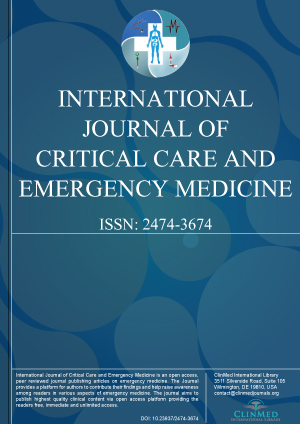Open Access DOI:10.23937/2474-3674/1510005
To Give or Not To Give - Is that the Question?: The Changing Face of Emergency Oxygen Therapy
Carol Ann Kelly and Dave Lynes
Article Type: Non-systematic Review | First Published: September 14, 2015
Oxygen's image, together with its reputation, is changing. No longer is it regarded as a benign panacea for all clinical presentations; indeed it is now increasingly evident that oxygen has the potential to contribute to clinical deterioration and mortality. There is an emerging recognition that oxygen is a drug when administered as a therapeutic intervention and should be used with caution. Contemporary guidelines offer criteria and directives for administration and prescription of oxygen, depe...
Open Access DOI:10.23937/2474-3674/1510003
Albuminuria in Critically lll Patients: A Prospective Cohort Study
oortje Godijn, Simone M Smits and Peter HJ van der Voort
Article Type: Original Article | First Published: August 14, 2015
In the intensive care unit (ICU) physicians are challenged to predict patient outcome when patients are admitted. Over the years, several tools have been developed for this purpose. Examples are the Acute Physiology and Chronic Health Evaluation (APACHE) and Sepsis Related Organ Failure Assessment (SOFA) scoring systems....
Open Access DOI:10.23937/2474-3674/1510002
Use of Dexmedetomidine in the Management of Alcohol Withdrawal Syndrome in Critically Ill Patients
Julie Kalabalik and Jesse B. Sullivan
Article Type: Review Article | First Published: July 30, 2015
Alcohol consumption plays a role in the development of over 200 diseases and conditions in individuals worldwide, including liver cirrhosis, cancers, traumatic injury, and alcohol dependence. In hospitalized patients with alcohol use disorders (AUD), up to 25% will develop acute alcohol withdrawal syndrome (AWS). In critically ill patients, presence of AWS is associated with increased duration of mechanical ventilation, prolonged intensive care unit (ICU) length of stay (LOS), more frequent infe...
Open Access DOI:10.23937/2474-3674/1510001
Protocols for Uncontrolled Donation after Circulatory Death: International & Comprehensive Analysis
Ivan Ortega Deballon
Article Type: Editorial | First Published: July 18, 2015
Determination of death, the exact moment that a person's death occurs, has been a constant challenge throughout human being history. What we already know is that death usually does not occur abruptly, at a specific time and for all parts of the body simultaneously. Human resistance to degradation by lack of oxygen varies depending on the type of cell and organ. It is possible, for example, for successful cornea transplants from deceased individuals as many as seven days after death. Actually, th...

